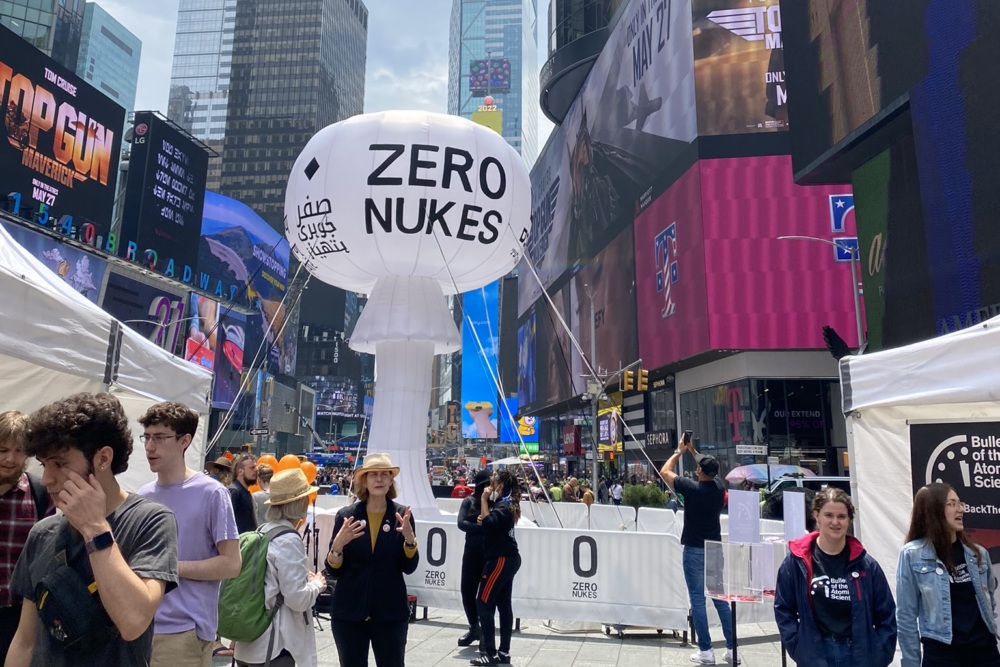
Hannah Hernandez
Intern, Communications
Atomic Pulse
About the image
Forty years ago, the release of the TV film The Day After (1983) sent a shock across the United States as more than 38 million households watched firestorms, human vaporization, irreversible destruction, and radiation poisoning follow the detonation of a nuclear bomb in Lawrence, Kansas. Yes, it was fiction, but viewers were terrorized at the prospect of a nuclear war between the U.S. and Soviet Union amid the Cold War arms race. President Ronald Reagan had recently re-authorized the production of the neutron bomb, pushed for an accelerated nuclear warhead production, initiated the Strategic Defense Initiative (otherwise known as Star Wars), and opposed arms control negotiations with the Soviet Union.
Reactions to the film combined with the unstable nuclear security landscape re-activated and empowered the anti-nuclear movement, launched after the 1945 atomic bombings of Hiroshima and Nagasaki. Viewers contacted the White House, pressing President Reagan to change his nuclear policy. Organizations and activists who supported disarmament and a halt on nuclear warhead buildup encouraged people to engage in the debate on nuclear weapons by registering to vote to elect officials who had disarmament on their agendas, participating in letter-writing campaigns to President Reagan, and marching in mass demonstrations to push Congress to adopt a nuclear freeze solution.
After watching The Day After, President Reagan recorded his reaction in his diary. “[The film was] very effective & left me greatly depressed … My own reaction was one of our having to do all we can to have a deterrent & to see there is never a nuclear war.” His views were reinforced after receiving pressure from the American people, who joined widespread anti-nuclear protests across the U.S. Following his 1984 reelection, President Reagan’s nuclear policy advocated for verifiable nuclear weapons reductions with the Soviet Union and future elimination of nuclear weapons – a stark contrast from his administration’s position during his first term in office. Through his persistence in nuclear arms control and disarmament talks with Mikhail Gorbachev, President Reagan helped bring about a vast reduction of U.S. and Soviet Union nuclear weapons.
The Day After inspired a president and the public to work for a world without nuclear weapons and directly changed U.S. nuclear policy. Today, with the release of Christopher Nolan’s Oppenheimer we have another opportunity to raise awareness and effect change.
A New Opportunity
Today, nuclear risks unquestionably are on the rise. President Biden has said that we are closer to nuclear Armageddon than at any time since the Cuban Missile Crisis. With Russia threatening to use nuclear weapons in the war in Ukraine, tensions escalating on the Korean Peninsula, and China building up its nuclear arsenal, the need to push for solutions to reduce the risk of nuclear use, and ultimately for a world without nuclear weapons, is more crucial than ever.
Considering the current nuclear landscape, the power of Christopher Nolan’s film and the moral and ethical questions raised by J. Robert Oppenheimer’s work, movie viewers once again may be motivated to act. But how?
Here are six ways to increase awareness of nuclear weapons and become an advocate for a world free of nuclear weapons.
Talk about it.
Initiating discussions on nuclear weapons with friends, family, colleagues, and members of your community is a great way to raise awareness and create space to develop creative ways to advocate for nuclear risk-reduction. Just as communities hosted events to encourage people to express their views on The Day After and learn more about nuclear security, conversing with others on Oppenheimer can help spark action on a broad scale to call for nuclear arms control and disarmament. Our experts are also available to discuss the film and today’s nuclear threats here.
Engage in campaigns.
Last year, NTI, working in partnership with Hiroshima and Nagasaki, reached more than 20 million people through our #CranesForOurFuture campaign which commemorates the anniversaries of the atomic bombings in Japan. Participants share pictures of paper cranes on social media with the hashtag #CranesForOurFuture to build public support for a world without nuclear weapons. This year’s campaign, our third, takes place from August 4th to August 9th. Anyone can be involved – we’ve had cultural and policy influencers like Yoko Ono and the United Nations Secretary-General join the campaign along with thousands of others from moms on TikTok to students across the country, from nuns in Ohio to members of Congress. Learn more about our campaign here—and please join us this year!
Contact your representatives.
Demanding that leaders keep us safe from nuclear weapons, cyber and artificial intelligence threats to nuclear command-and-control systems, and a nuclear arms race with China and Russia will influence politicians to put nuclear weapons issues on their agenda. Contacting representatives is especially important as the 2024 elections approach. A candidate’s nuclear weapons policy can significantly alter the nuclear security landscape, as seen during the Cold War. Individuals have a direct way of influencing nuclear policy.
Learn more about the history of nuclear weapons.
NTI offers a wide range of materials to equip those interested in nuclear security with the tools needed to understand what nuclear weapons are, how they work, who has them, and what solutions institutions have developed to address nuclear threats.
Our Education Center offers information on nuclear treaties and regimes, nuclear and missile facilities, and a glossary of terms commonly used when referencing nuclear security. It also includes a Tutorials page that covers topics such as the basics of nuclear energy and nuclear weapons, missile delivery systems, nonproliferation, and nuclear testing. For students, teachers, and professors, we also offer a Nuclear Materials Security module, a Teacher’s Guide, a Toolbox, and a Nuclear Weapons Syllabus.
Keep up-to-date on nuclear security news.
NTI publishes a newsletter every other week to keep subscribers up-to-date on our work to reduce nuclear threats, upcoming events, and how to take action. Most recently we launched the 2023 NTI Nuclear Security Index which tracks the progress of global nuclear and radiological security across 175 countries and Taiwan and recommends steps governments, institutions, and civil society can implement to better protect nuclear facilities, materials, and weapons from threats.
Donate to organizations that are working to build a safer world.
NTI is dedicated to developing innovative, pragmatic solutions to reduce nuclear weapon risks and threats. Organizations that work on nuclear risk-reduction and disarmament have historically led the movements for a nuclear weapons-free world that have compelled politicians in various levels of government to act. By supporting the work of our organizations and others in the field, you can help us continue to make progress toward a world without nuclear weapons for current and future generations.
Sign up for our newsletter to get the latest on nuclear and biological threats.
If you want to learn more about Oppenheimer’s bomb and what we must do to protect the world today and for future generations, NTI’s online library is the perfect place to go.
From May 17-24, 2022, Times Square Arts presented Amnesia Atómica NYC, a public exposition commissioned by the Bulletin of Atomic Scientists centered around artist Pedro Reyes’s ZERO NUKES: a 30 foot tall, mushroom cloud-shaped inflatable sculpture.
Eugenia Zoloto is a Ukrainian artist who specializes in paper cutting, collages, and illustrations, in addition to working with oil paints and mixed mediums. She lives in Kyiv with her husband and two children and is participating in the 2023 #CranesForOurFuture campaign by contributing a beautiful floral sculpture featuring an origami crane.



